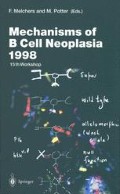Abstract
The small pre-B II cells, such as those that can be found in the bone marrow, form the direct precursor pool of immature B cells that first express IgM at their surface. Experiments by Osmond and his colleagues have shown that mice produce about 2 x 107 of these immature B cells per day [1]. Some of them are thought to exit bone marrow [2] and home to extrafollicular areas of the spleen [3]. At these sites in the spleen, B cells are still immature and can be distinguished from their mature counterparts by their half-life (3–4 days versus 6 weeks), their lower B220 and slgD and their higher HSA and slgM expression levels [4; 5]. Experiments by a number of investigators have shown that only 5–10% of the newly generated immature B cells are selected into the pool of long-lived mature B cells [1; 3; 4; 6; 7]. Why and how only such a small proportion of immature B cells is selected is largely unknown.
Access this chapter
Tax calculation will be finalised at checkout
Purchases are for personal use only
Preview
Unable to display preview. Download preview PDF.
References
Osmond DG. (1991) Proliferation kinetics and the lifespan of B cells in central and peripheral lymphoid organs. Curr Opin Immunol 3: 179 – 185
Allman DM, Ferguson SE, Lentz VM, and Cancro MP. (1993) Peripheral B cell maturation. II. Heat-stable antigenhi splenic B cells are an immature developmental intermediate in the production of long lived marrow-derived B cells. J Immunol 151: 4431 - 4444
MacLennan I, and Chan E. (1993) The dynamic relationship between B-cell populations in adults. Immunol Today 14: 29 - 34
Förster I, and Rajewsky K. (1990) The bulk of the peripheral B-cell pool in mice is stable and not rapidly renewed from the bone marrow. Proc Natl Acad Sci USA 87: 4781 – 4784
Hardy RR, Carmack CE, Shinton SA, Kemp JD, and Hayakawa K. (1991) Resolution and characterization of proB and pre-pro B cell stages in normal mouse bone marrow. J Exp Med 173: 1213 – 1225
Thomas-Vaslin V, and Freitas AA. (1989) Lymphocyte population kinetics during the development of the immune system. B cell persistence and life-span can be determined by the host environment. Int Immunol 1: 237 – 246
Sprent J. (1993) Lifespans of naive, memory and effector lymphocytes. Curr Opin Immunol 5: 433 – 438
Rolink AG, Melchers F, and Andersson J. (1998) Characterization of immature B cells by a novel monoclonal antibody, by turnover and by mitogen reactivity. Eur J Immunol 28: 3738– 3748
Hardy RR, and Hayakawa K. (1991) A developmental switch in B lymphopoiesis. Proc Natl Acad Sci USA 88: 11550 – 11554
Kontgen F, Suss G, Stewart C, Steinmetz M, and Bluethmann H. (1993) Targeted disruption of the MHC class II Aa gene in C57BL/6 mice. Int Immunol 5: 957 – 964
Widera G, Burkly LC, Pinkert CA, Bottger EC, Cowing C, Palmiter RD, Brinster RL, and Flavell RA. (1987) Transgenic mice selectively lacking MHC class II (I-E) antigen expression on B cells: an in vivo approach to investigate la gene function. Cell 51: 175 – 187
Yamamura K, Kikutani H, Folsom V, Clayton LK, Kimoto M, Akira S, Kashiwamura S, Tonegawa S, and Kishimoto T. (1985) Functional expression of a microinjected Ed alpha gene in C57BL/6 transgenic mice. Nature 316: 67 – 69
Shachar I, and Flavell RA. (1996) Requirement for invariant chain in B cell maturation and function. Science 274: 106 – 108
Kenty G, Martin WD, Van Kaer L, and Bikoff EK. (1998) MHC class II expression in double mutant mice lacking invariant chain and DM functions. J Immunol 160: 606 – 614
Cosgrove D, Gray D, Dierich A, Kaufman J, Lemeur M, Benoist C, and Mathis D. (1991) Mice lacking MHC class II molecules. Cell 66: 1051 – 1066
Markowitz JS, Rogers PR, Grusby MJ, Parker DC, and Glimcher LH. (1993) B lymphocyte development and activation independent of MHC class II expression. J Immunol 150: 1223 – 1233
Ruberti G, Paragas V, Kim D, and Fathman CG. (1993) Selection for amino acid sequence and J beta element usage in the beta chain of DBA/2V beta b- and DBA/2V beta a-derived myoglobin-specific T cell clones. J Immunol 151: 6185 – 6194
Anderson GD, Banerjee S, and David CS. (1989) MHC class IIA alpha and E alpha molecules determine the clonal deletion of V beta 6+ T cells. Studies with recombinant and transgenic mice. J Immunol 143: 3757 – 3761
Anderson GD, and David CS. (1989) In vivo expression and function of hybrid la dimers (E alpha A beta) in recombinant and transgenic mice. J Exp Med 170: 1003 – 1008
Matsunaga M, Seki K, Mineta T, and Kimoto M. (1990) Antigen-reactive T cell clones restricted by mixed isotype A beta d/E alpha d class II molecules. J Exp Med 171: 577 – 582
Mineta T, Seki K, Matsunaga M, and Kimoto M. (1990) Existence of mixed isotype A beta E alpha class II molecules in Ed alpha gene-introduced C57BL/6 transgenic mice. Immunology 69: 385 – 390
Author information
Authors and Affiliations
Editor information
Editors and Affiliations
Rights and permissions
Copyright information
© 1999 Springer-Verlag Berlin Heidelberg
About this paper
Cite this paper
Rolink, A.G., Melchers, F., Andersson, J. (1999). The Transition from Immature to Mature B Cells. In: Melchers, F., Potter, M. (eds) Mechanisms of B Cell Neoplasia 1998. Current Topics in Microbiology and Immunology, vol 246. Springer, Berlin, Heidelberg. https://doi.org/10.1007/978-3-642-60162-0_5
Download citation
DOI: https://doi.org/10.1007/978-3-642-60162-0_5
Publisher Name: Springer, Berlin, Heidelberg
Print ISBN: 978-3-642-64283-8
Online ISBN: 978-3-642-60162-0
eBook Packages: Springer Book Archive

